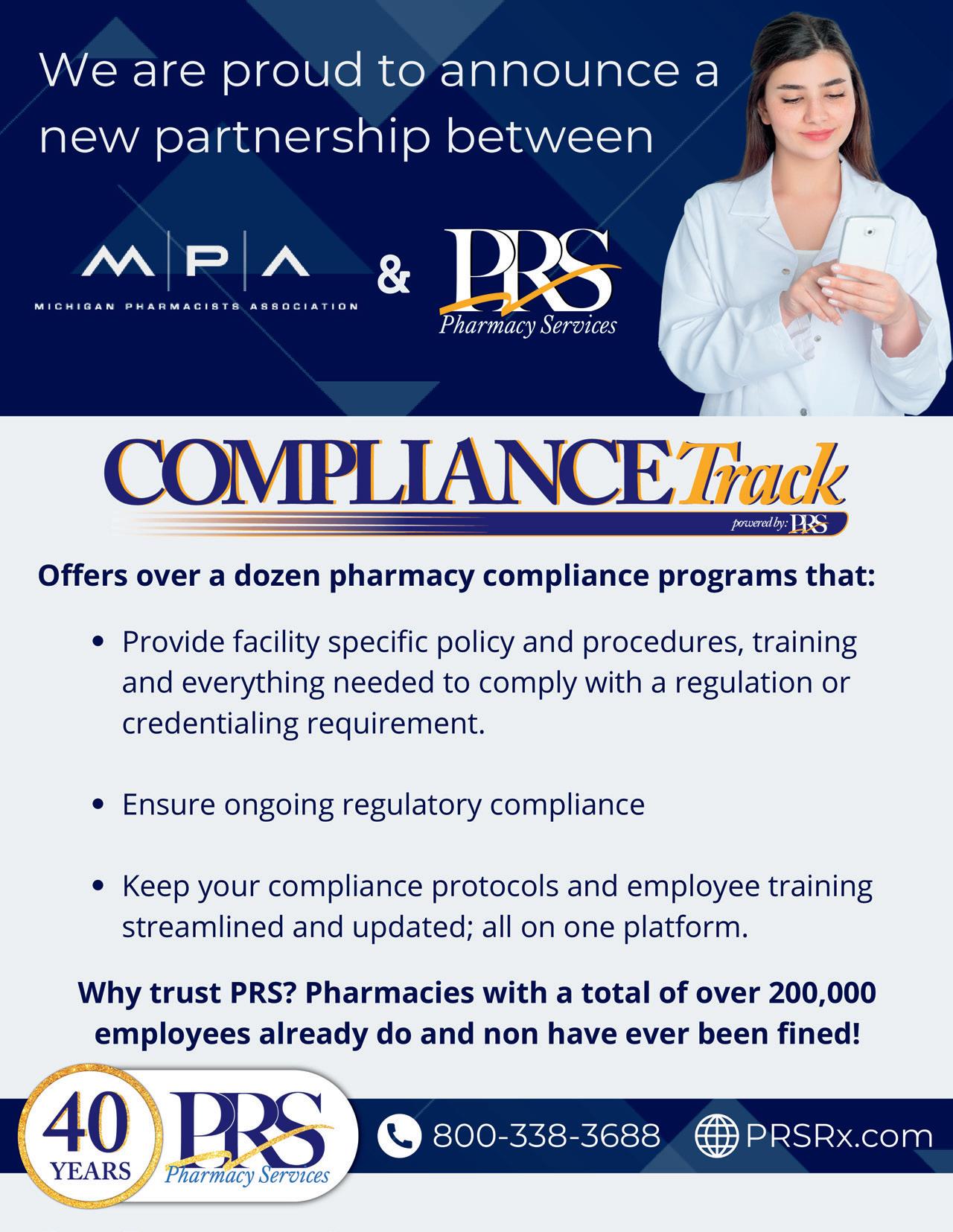THE PRESSURE

NOT JUST SKIN DEEP
TECHS IN FOCUS




President Mike Crowe reflects on growth in 2022 and MPA's next steps.
MPA is dedicated to continuing its long tradition of championing pharmacy technicians.
MPA's membership survey reveals the value of each of its products and services.

Adam King,
president, illuminates how
tech opportunities have expanded.
What pharmacy professionals need to know about changes in reproductive health care.


Earn free continuing education credit about pharmacy's critical role in tobacco cessation.
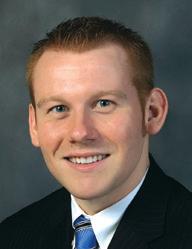
As I stated in my campaign, unity and protection of pharmacy is my purpose as I serve as your president this year. One of the first and most significant opportunities I saw to work toward this was to optimize our volunteer base. The association needs the direction of a diverse group of members engaging in volunteer groups, such as boards and committees. I wanted the right volunteer groups to exist with the right representation and for there to be a clear and simple process to become part of them, in hopes that there was no missed opportunity to plug in a member’s expertise and passion. Because of the support and collaboration of MPA staff, the MPA Executive Board, and the boards of directors of the Michigan Society of Health-System Pharmacists (MSHP) and the Michigan Society of Community Pharmacists (MSCP), I feel we’ve been able to do that this year. Here’s a summary of the specific improvements readied for 2023:
• Four New MPA Committees. Although they were previously joint committees with MSHP, the MPA Membership and Public Affairs committees are technically new MPA committees that, in 2023, will emphasize involvement of all MPA practice sections. We have also established an MPA Marketing Committee and, seeing its continued importance, established the former MPA Workplace Environment Task Force as its own standing committee.
• Committee Charters. We now have charters for each of MPA’s eight committees, which go beyond the committee charges to include a purpose, leadership structure and composition. Importantly, each charter prescribes the involvement of members from all MPA practice sections.
• Four Dissolved Committees. We dissolved the joint MPA-MSHP Membership and Public Affairs committees in recognition of the new, overarching MPA equivalents. MSHP also agreed to dissolve its Professional & Legal Affairs Committee, and MSCP dissolved its Education & Communications Committee, which freed up two MPA staff members from committee liaison responsibilities.
• Member Engagement Form. Working together with all the practice sections, we were able to create a new universal engagement form representing almost every opportunity MPA offers for members to get involved (all committees, practice sections, locals and regionals). If you didn’t have a chance to complete it, I encourage
you to do so now; openings and vacancies are always a possibility. Next year, I hope that the attributes of this form will become a part of each member’s digital profile and that it is kept up to date, so that at any given time, leadership can run a report and help connect members with engagement opportunities.
• MPA Committee Day. Taking a cue from MSHP, I’m happy to report that the first MPA Committee Day, a uniting event to kick off committee work for 2023, will take place Jan. 19, 2023.
• Michigan Pharmacy Foundation. Although this item isn’t focused on getting members engaged within MPA volunteer roles today, I would say that is definitely an aspiration of the Foundation. Thanks to the work of the MPF Board of Trustees and new Executive Director Rick Drabek, the Foundation now has a strategic plan to guide its work in 2023 and beyond. Some may have wrongly seen MPF as simply the scholarship- and grant-giving arm of MPA, but with this new plan and mission (“To Foster the Future of Pharmacy”), I see MPF tying in with MPA on a much more strategic and significant level.
I’m excited for 2023 as I know we’ll continue to not just do things one way because we’ve always done them that way. Upcoming changes in the MPA Annual Convention & Exposition, Pharmacy Day at the Capitol and other activities will illustrate that.
I have two requests from members to conclude this Platform. The first is easy, but important: you will see information in this quarter’s issue about our presidentelect candidates. Please remember to vote in this year’s MPA election. Second, if you are appointed to a committee for 2023, please make it a priority to attend its meetings. I think, in some ways, COVID-19 got us accustomed to being a little less engaged; let’s kick that habit and realize how important our engagement is to our profession.
I look forward to serving as chair next year and working with your incoming 2023 President Hope Broxterman. I realize I still have several weeks to serve as your President, but I want to thank you for a great year. Everyone whom I’ve had the chance to work with has been delightful and encouraging. We really do have the best members making up the best state pharmacy association. As my friends and I call it, thank you for being part of my pharmily.
"We really do have the best members making up the best state pharmacy association."
technicians represent a growing profession and are a valuable asset in every pharmacy setting. The Michigan Pharmacists Association (MPA) is a leader in recognizing the importance of pharmacy technicians and building a pathway for their continued success.
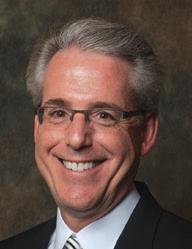
The pharmacy technician profession is steeped in history with MPA. In 1995, the Pharmacy Technician Certification Board (PTCB) was established by MPA, the Illinois Council of Health-System Pharmacists (ICHP), the American Pharmacists Association and the American Society of Health-System Pharmacists and joined in 2001 by the National Association of Boards of Pharmacy.
In fact, it was my predecessor, Larry Wagenknecht, who teamed with his counterpart from ICHP to start discussions about forming PTCB. Now, more than 25 years later, PTCB is a $15 million organization, having certified more than 750,000 pharmacy technicians. PTCB recently announced that more than 1,000 pharmacy technicians have earned their Advanced Certified Pharmacy TechnicianTM (CPhT-AdvTM) credential since the program’s launch in late 2020. This advanced certification is the first of its kind in the industry and recognizes experienced technicians taking on expanded responsibilities as critical pharmacy team members.
I am proud to represent MPA on the PTCB Board of Governors and equally pleased to announce the addition of the National Community Pharmacists Association (NCPA) as a new member of the board.
MPA’s support of pharmacy technicians goes all the way back to 1984 when the Michigan Society of Pharmacy Technicians (MSPT) became an affiliated chapter of MPA, complete with its own board of directors and representation on the MPA Executive Board. Today, the MSPT Board of Directors meets four times a year to craft priorities to advance pharmacy technicians in Michigan through education and networking opportunities.
As the staff liaison to the MSPT board, I work throughout the year with MSPT leadership to incorporate MSPT priorities into the MPA Strategic Plan. MSPT directors don’t have it easy, juggling their real jobs with their role as volunteers. I’d like to thank our current MSPT board officers for their incredible dedication.


I’m often asked, “Why belong to MPA?” My answer changes depending on the practice setting, but MSPT represents technicians in all areas of practice.
First, technicians receive all benefits of MPA membership, including discounted continuing education at in-person and virtual events and MSPT representation on the MPA Executive Board. Pharmacy Technician immunization training, Pharmacy Tech Prep Online, the Pharmacy Certified Technician Training Manual and Calculations Workbook, and the Certified Compounding Sterile Preparation Technician Exam Study Guide are some of the resources available through MSPT/MPA. In addition, you will get your practice questions answered by MPA’s expert staff, and you will have access to MPA's online career center and NEW Annual Convention & Exposition (ACE) Career Fair, featuring job postings, interview techniques, resume reviews and in-person interviews. Don’t forget the networking opportunities available at the local level through complimentary membership in one of MPA’s 12 local associations!
If you’re a pharmacy technician, I invite you to become engaged in MSPT. Involvement with your peers will lead you to greater heights in your profession. And, if you’re a pharmacist, please invest in your pharmacy technicians. The returns are well worth the investment!

MPA events, as well as health observances, are included below. For the most up-to-date information, please visit our online calendar at www.MichiganPharmacists.org/eventscalendar
Saturday, Oct. 1 –Monday, Oct. 31
American Pharmacists Month Nationwide
16-22
27
Saturday, Oct. 1 –Monday, Oct. 31 Health Literacy Month Nationwide
Sunday, Oct. 16 –Saturday, Oct. 22
National Pharmacy Week Nationwide
Thursday, Oct. 27
MSHP Board of Directors Meeting
Tuesday, Nov. 1 –Wednesday, Nov. 30
American Diabetes Month Nationwide 1-30
Tuesday, Nov. 1 –Wednesday, Nov. 30
COPD Awareness Month Nationwide
Monday, Nov. 7
MPA Executive Board Meeting
Virtual Only 10
Thursday, Nov. 10 CSPM Board of Directors Meeting
Virtual Only
Thursday, Dec. 1 –Wednesday, Dec. 7 National Handwashing Awareness Week Nationwide
Monday, Dec. 5 –Sunday, Dec. 11 National Influenza Vaccination Week Nationwide
Friday, Dec. 23 –Monday, Dec. 26
MPA Office Closed: Christmas Holiday MPA Headquarters, Lansing
Friday, Dec. 30
Suburban Collection Showplace, Novi 28
17
Friday, Oct. 28
2022 MSHP Annual Meeting Suburban Collection Showplace, Novi
Thursday, Nov. 17 MPF Board of Trustees Meeting
Hybrid: Virtual/MPA Headquarters, Lansing
Friday, Nov. 18 –Thursday, Nov. 24
U.S. Antibiotic Awareness Week Nationwide
18
Friday, Nov. 18
MSPT Board of Directors Meeting
Hybrid: Virtual/MPA Headquarters, Lansing
Thursday, Nov. 24 –Friday, Nov. 25
MPA Office Closed: Thanksgiving MPA Headquarters, Lansing
Tuesday, Nov. 29
MSCP Board of Directors Meeting
Virtual Only
MPA Office Closed: New Year's Eve MPA Headquarters, Lansing
Please note: Some board and committee meetings may be subject to a change in format to virtual or in person at the discretion of the members. Please check the online calendar or contact MPA@MichiganPharmacists.org for more information.
As a nationally recognized leader in the development of technician training resources, the Michigan Pharmacists Association (MPA) has developed Pharmacy Technician Immunization Administration training recognized as fulfilling the education requirement for the Pharmacy Technician Certification Board (PTCB) Immunization Administration Certificate Program. The homestudy portion of the course must be completed prior to joining the live review webinar.
www.MichiganPharmacists.org/education/pharm_tech_immun
The next offering of the American Pharmacists Association’s (APhA) Pharmacy-Based Immunization Certification Course facilitated by the Michigan Pharmacists Association (MPA) is now open for registration! The LIVE review webinar will take place from 3:30 p.m. to 5:30 p.m., Wednesday, Oct. 26. The homestudy portion of the course must be completed prior to joining the live review webinar. More information about the course offering, what is needed and how to register can be found on MPA's website.
www.MichiganPharmacists.org/Education-Events/Pharmacy-basedImmunization-Delivery-Program
The Michigan Society of Health-System Pharmacists (MSHP) Annual Meeting will be held Friday, Oct. 28, at the Suburban Collection Showplace at 46100 Grand River Ave., Novi, Mich.
Held each fall, the MSHP Annual Meeting offers up to six hours of live continuing education credit. Programming is geared toward health-system pharmacists, residents, pharmacy technicians and student pharmacists. Tracks focus on clinical, leadership management and residency topics as well as other general areas of pharmacy practice.
In addition to continuing education programs, the event offers the annual MSHP Town Hall Meeting to officially install new MSHP Board of Directors members into office, recognition of volunteers and award recipients, a clinical skills competition for students and an exhibit hall to provide attendees with a chance to exchange ideas and learn about new products and services.
The Michigan Pharmacists Association (MPA) is offering a series of implicit bias trainings to meet the new licensure requirement that took effect June 1. The rules require a minimum of two hours of implicit bias training within the five years immediately preceding issuance of the license or registration and an ongoing minimum of one hour of implicit bias training for each year of the applicant’s license or registration cycle. This course is not accredited for continuing education but satisfies the new licensure requirement.
Michigan Pharmacists Association (MPA) is accredited by the Accreditation Council for Pharmacy Education (ACPE) as a provider of continuing pharmacy education.

Kentaja Johnson joins the Michigan Pharmacists Association (MPA) as the administrative assistant. She graduated from Sexton High School in 2019 and became a Bronco at Western Michigan University. Since then, she’s joined the workforce in hope of finding her desired field of work, before finishing her bachelor’s degree at WMU. She previously was an administrative assistant for the Capital Area Transportation Authority in Lansing. In her free time, she loves to take pictures, paint and do hot yoga.

Richard (Dick) Allan Peterson died at home Friday, Aug. 19 at age 77 under hospice care after a long-term battle with cancer. He was a member of the Michigan Pharmacists Association for 28 years.
Peterson was a Yooper, graduating from Graveraet High School in Marquette, Mich. in 1962. He then graduated from Ferris State University College of Pharmacy. He was married to Therese Duszynski, the love of his life, until her death 16 years ago.
After retirement, Peterson went on several medical missions to Africa and Central America. He moved to Venice, Fla. three years ago. He enjoyed golf, tennis, fishing and snow skiing.
Peterson is survived by his sister Natalie (Peter) Knudson and his brother Ed (Lynne) Peterson. He was also the beloved uncle of many. Peterson is buried in the Evergreen cemetery next to Therese. Donations in Dick's name should be sent to your local hospice or the American Cancer Society. A message of condolence may be sent by visiting www.farleyfuneralhome.com
The Michigan Pharmacists Association (MPA) is pleased to announce that the 2023 Annual Convention & Exposition (ACE) will be held at the Detroit Marriot at the Renaissance Center from Friday, Feb. 24 to Sunday, Feb. 26, 2023. MPA staff is very excited to bring Michigan pharmacy professionals together in person once again in Detroit! MPA staff will be monitoring health safety precautions and doing everything possible to ensure all participants stay safe and healthy at this event. MPA is committed to providing you with quality continuing education programming and networking opportunities, as well as a chance to visit with vendors.
Registration will open in early December. Watch for upcoming communications from MPA to learn more about details as they become available. See you in Detroit!

 BY SHANNON HABBA,
BY SHANNON HABBA,
Doctor of Pharmacy candidate, class of 2025, Wayne State University; chapter president, APhAASP

The Doctor of Pharmacy candidates of Wayne State University’s (WSU) Eugene Applebaum College of Pharmacy and Health Sciences have been equipped with the tools required to overcome adversity, despite the challenges presented throughout the COVID-19 pandemic. Pharmacists have emerged in the spotlight as healthcare providers, from leading the country’s COVID immunization and testing efforts to obtaining the ability to prescribe Paxlovid under the U.S. Food & Drug Administration (FDA) emergency use authorization. As we transition to a hopeful post-pandemic era, the WSU American Pharmacists Association - Academy of Student Pharmacists (APhA-ASP) and the Student Michigan Pharmacists Association (SMPA) student leaders are working diligently to keep students engaged in pharmacy advocacy and policy reform.
Every year, student pharmacists look forward to attending Pharmacy Day at the Capitol (PDAC), an event hosted by the Michigan Pharmacists Association (MPA). PDAC gives pharmacy professionals across the state of Michigan the opportunity to speak with legislators on the value of our profession in healthcare and policies that affect pharmacy, including those that expand a pharmacist’s scope of practice. As advocacy continues to be a top priority, student pharmacists from Wayne State University, Ferris State University and the University of Michigan returned to PDAC at the Capitol in Lansing in September 2021 for the first time since the COVID-19 pandemic began. For many students, it was their first time attending PDAC, speaking to a legislator or simply learning more about policies that influence the profession of pharmacy. As a result, collaboration with government officials through PDAC and other continued efforts led to Gov. Gretchen Whitmer signing pharmacy benefit manager (PBM) reform into law; this is one of many great examples of how critical it is for pharmacy
professionals to partake in policy reform. Unfortunately, student pharmacists did not have the opportunity to attend PDAC this year because it was canceled. Although PDAC has always been one of the most accessible methods of communicating with legislators, it surely is not the only one. Student pharmacists at WSU have set out to open alternative doors of engagement with their respective legislators to keep moving pharmacy forward and lead with the courage to change. Following the initiative of WSU’s Omicron Chapter of Lambda Kappa Sigma (LKS), student pharmacists from WSU’s chapters of APhAASP, SMPA and other pharmacy student organizations throughout the state plan to join the campaign efforts on House Bill 5655 (2021) – expanding the scope of pharmacists to prescribe and dispense certain contraceptives. The campaigning efforts include collaborating with other student pharmacists, calling legislators, writing letters and seeking additional means of educating others on the importance of such policies. Undoubtedly, the desired outcome is to see House Bill 5655 signed into law, but it is also desired that such campaign efforts can be reproduced by future pharmacy professionals on their journey to policy reform and advocacy.
Now with greater reason, student pharmacists and pharmacists need to amplify their voices and continue sharing their perspectives. PDAC is one channel of communication available to connect with public officials and include them on the journey to pharmacy advocacy, but there are several others to capitalize on as well. Pharmacy experts must continue to engage and educate other leaders and healthcare professionals on pharmacy’s role in health care, as it is crucial to the advancement of medicine.
The Michigan Pharmacy Foundation’s (MPF) Mission is to “Foster the Future of Pharmacy.” One way that the Foundation accomplishes this is to award future pharmacists scholarships to help defray some of their pharmacy educational expenses. MPF awards a $2,500 scholarship to a current P2, P3 or P4 student pharmacist from each of the three accredited colleges of pharmacy in the state of Michigan.
The MPF Scholarship criteria are for a student pharmacist who demonstrates:
• Exceptional academic performance
• Leadership ability
• Record of professional achievements
• Active student membership in the Michigan Pharmacists Association (MPA)
In addition to the MPF scholarships, each year MPF awards the Larry Wagenknecht Leadership Scholarship in honor of his 37 years of dedication to the practice of pharmacy and leadership as past CEO of MPA. This $3,000 scholarship is awarded to a student who has demonstrated exceptional leadership capabilities.
The deadline for all MPF scholarship applications is Nov. 6. MPF encourages members of the pharmacy profession to reach out to student pharmacists they know and encourage them to apply for these scholarship opportunities. Student MPA members can access the application for these scholarships at: www.michiganpharmacists.org/ foundation/scholarships
MPF looks forward to announcing the scholarship winners on Feb. 25 at the 2023 MPA Annual Convention and Exposition (ACE), which will be held at the Detroit Renaissance Center.


If you have any questions about MPF scholarships, please contact MPF Executive Director Rick Drabek at (517) 377-0227 or via email: RDrabek@ MichiganPharmacists.org
Two of last year’s MPF scholarship recipients, Maria Gonzalez Chavez, above, and Kiara Torres Garcia, below, winner of the Larry Wagenknecht Leadership Scholarship, both from Ferris State University, are recognized at the MPA Annual Convention & Exposition in February earlier this year. The MPF Student Scholarship Program provides funding to Michigan student pharmacists in recognition of their leadership, academic and professional achievements.


Whentalking about the impact pharmacists have in the lives of their patients, Amber Martirosov, Pharm.D., recalls a patient who lost both his father and mother in their mid-50s to the consequences of untreated high blood pressure.
“He knew his parents had died from the negative effects of hypertension, but he didn’t realize that he had hypertension himself,” she said. Hypertension, often called the “silent killer” for its lack of obvious symptoms, affects about one-third of all Americans. It is a major risk factor for heart disease and stroke, the leading and fifth-leading causes of death in the U.S., respectively, according to the United Health Foundation. While it can be controlled through a combination of diet, exercise and medication, many at-risk patients experience barriers to this needed care.
That is why a program at Henry Ford Health System (HFH) this year received funding through a grant from the Michigan Pharmacy Foundation (MPF) to sustain work originally started – and funded – last year by the ambulatory care pharmacists themselves. The pharmacists recognized a need many of their Detroit-based patients faced, and they decided to raise funds to provide blood pressure cuffs for free to reduce patients’ barriers to self-monitoring.
For patients like the young Black father who lost both parents, access to care, education and the tools to self-monitor can truly be the difference between life and death, explained Martirosov, Pharm.D., BCPS, BCACP, a clinical pharmacy specialist and the ambulatory care pharmacy graduate year two (PGY2) residency program director at HFH.
“He has young kids, and he doesn’t want his children to experience the same kind of loss that he did over something he now realizes he has a little bit more control over,” Martirosov said. “I think it’s been a combination of the pharmacists’ education and his ability to self-monitor at home that has really allowed him to link the dots and see that the medication is
working. That has then kept him adherent, and he’s been adherent and stayed at his blood pressure goal for a year now.”
Each ambulatory care pharmacist in HFH’s seven internal and family medicine clinics receives referrals from physicians – via the delegated authority of collaborative practice agreements (CPA) – to manage patients’ antihypertensive regimen and educate patients on medication adherence, lifestyle changes and blood pressure monitoring. Although pharmacists assessed home blood pressure readings before, there was no process in place to help those unable to afford a monitor for at-home use, which can cost between $25 to $100.
Rachel Stein, Pharm.D., PGY2 ambulatory care pharmacy resident for 2021-2022, is now coordinating this program, which was begun in 20202021 by her predecessor and is already showing positive results.

“We’ve been able to show that the patients that did receive a blood pressure cuff have less of a negative change in their blood pressure six to 12 months after their last contact with their pharmacist,” Stein said.



Martirosov emphasized that pharmacists can provide education, but it’s up to the patients themselves to make these changes – which is why self-monitoring at home is so empowering.
“We’re ‘leading them to water,’ but we’re also demonstrating here’s all the tools that will make you successful,” she said. “We are empowering
them to do what they need to do, so that they can be successful in taking control of their own health care.”
Jamie (George) Alex, Pharm.D., MBA, HFH’s previous PGY2 ambulatory care pharmacy resident and a current clinical pharmacy specialist of hematology/oncology at Henry Ford Macomb, began the program in 2020. She collected HFH employee donations through a two-month fund drive. In 2021, these donations purchased 44 blood pressure monitors from the HFH outpatient pharmacy at cost, which were then distributed to patients who needed them for free.
This year, with funding from MPF, that number grew to 118 cuffs.
“For those disadvantaged by health disparities, such as difficulties with transportation to the clinic and/or inability to afford a BP monitor, this (program allows) the patients to be able to monitor their BP at home and be more proactive about their health,” wrote Alex in a recent article in the Michigan Society for Health-System Pharmacists’ (MSHP) Monitor newsletter. “Patients who received the monitors (are) able to associate their home BP readings to lifestyle and medication adherence, which (can) improve overall patient outcomes and help patients reach their goal BP.”
Nancy MacDonald, Pharm.D., BCPS, FASHP, coordinator of transitions of care & emergency preparedness for the department of pharmacy services at HFH, said this program makes pharmacy unique within the health system, emphasizing that employees themselves took the initiative to donate the funds to buy the first round of blood pressure cuffs for patients.
MacDonald added that the program aligns with the American Society of Health-System Pharmacists’ Practice Advancement Initiative 2030 recommendations for patient-centered care.
“Whenever you have a patient engaged in their care, they’re more adherent,” she explained.
MacDonald said their hope is to expand this kind of assistance beyond hypertension to other populations facing conditions like asthma, chronic obstructive pulmonary disease or interstitial lung disease, where access to tools can be equally beneficial.
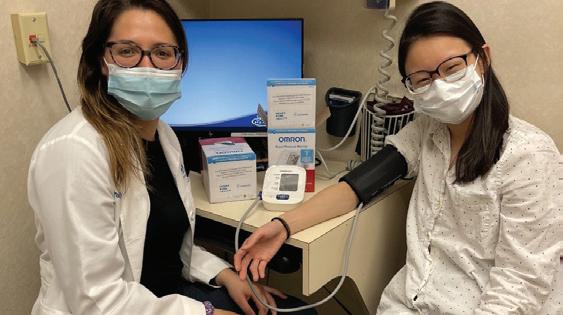
Programs like this also serve to highlight the critical role pharmacy professionals play in serving patients and improving health outcomes,
which the general public often does not see.
Stein said she will certainly take this experience with her as she grows in her career.
“One of my goals as a pharmacist is to empower patients to take an active role in their health care,” Stein said. “It is amazing that by partnering with MPF, we can give patients a tool to assist in the management of their chronic disease states, including hypertension.”


Over the past 20 years, MPF has awarded more than $275,000 in grant funding, typically allocating $10,000-15,000 annually. MPF accepts grant applications from individual pharmacy professionals, including pharmacy residents, student pharmacists, pharmacy organizations, colleges of pharmacy and pharmacy businesses. The deadline to apply for grants is Oct. 16, with determinations made by Jan. 15.
For more details about the MPF grant program or to print an application, visit www.MichiganPharmacists.org/foundation/grants or contact MPF Executive Director Rick Drabek by email at RDrabek@ MichiganPharmacists.org or phone at (517) 377-0227.
Left, Rachel Stein, Pharm.D., PGY2 ambulatory care pharmacy resident 20212022 at Henry Ford Health System, takes a patient's blood pressure as part of the ongoing blood pressure monitoring program begun by Jamie George, Pharm.D, MBA, clinical pharmacy specialist – hematology/oncology at Henry Ford Health System. The program has received funding through a grant from the Michigan Pharmacy Foundation for 2022 to continue operating.
“We’ve been able to show that the patients that did receive a blood pressure cuff have less of a negative change in their blood pressure six to 12 months after their last contact with their pharmacist.”


The Michigan Pharmacists Association’s (MPA) is focused on moving key pieces of legislation this fall that would allow a pharmacist to independently administer any immunization without the need for a collaborative practice agreement. The new bills, to be introduced in the House of Representatives soon, would also allow pharmacists to bill for these services. Additionally, MPA is advocating for legislation that would allow pharmacists to prescribe oral contraceptives to patients. MPA continues to be the voice of pharmacy in Lansing, fighting for fair reimbursements from pharmacy benefit managers and the state of Michigan.
Unfortunately, MPA was forced to make the difficult decision to cancel MPA’s annual Pharmacy Day at the Capitol (PDAC). The Michigan Senate and House of Representatives originally planned to meet for 15 days between September and October, but the legislators decided to cancel all but two of those days so they could campaign for reelection in their home districts. The two days they decided to meet did not coincide with PDAC, and, because the Capitol facilities were already reserved, MPA had no option to move to one of those dates.
Between now and the end of the year, the Legislature plans to meet a total of 12 days, and, depending on the outcome of the election, those 12 days may be reduced even further. However, just because the Legislature won’t be working on policy does not mean that we shouldn’t continue to advocate for our profession and the legislation that would move us forward.
MPA members have access to our VoterVoice software that allows them to contact their legislator with the click of a button. The software can be found on the MPA website under the “Advocacy Action Center” dropdown called “MPAction.” There, members will find the letter on the next page to be able to customize as they see fit. After customizing the letter, members can simply input their address and hit “send.” This is the easiest way to advocate for the pharmacy profession and ensure that pharmacy remains on the minds of legislators and staff even when they are not in Lansing. Visit our MPAction page and email your legislator today.

My name is _____________, and I am a pharmacy professional who lives and works in your district. You may not be aware, but October is National Pharmacist Month, and the week of Oct. 16 is “Pharmacy Week” in Michigan. During the week, we celebrate our pharmacists, pharmacy technicians and student pharmacists for all the hard work that they do serving their patients.
Normally, the Michigan Pharmacists Association holds an annual advocacy day in the fall, and I would have come to your office during this event, but I understand this is an election year and that some of your time in Lansing was cut short. I would like to take this opportunity to share with you everything that pharmacy professionals are able to do, what we have been doing to help keep Michigan patients healthy and safe, and what we need in order to continue this work.
Let’s start with schooling. Did you know there are three colleges of pharmacy in Michigan at Wayne State University, Ferris State University and the University of Michigan? Since 2000, all student pharmacists who have graduated from one of Michigan’s colleges of pharmacy have received a doctorate. We attend school for at least six years. If we do a residency, we add another one to two years onto our education. We are the medication experts. We know which medications will interact with each other, and we know how to keep our patients safe from any adverse reactions. However, medication safety isn’t the only thing we know how to do. We are taught a number of skills in school, such as how to do a blood pressure screening, educate a patient on diabetes and the correct technique to immunize any patient.
The past two years have been hard for everyone. However, when many people were being ordered to remain home, and businesses and doctors’ offices were closing down, pharmacies remained open. During the pandemic, pharmacists gave the majority of the vaccines in the state, ensuring the public remained healthy at a significant risk to ourselves and our loved ones. We continue to serve our patients now as the world is returning to normal. A major side effect of the pandemic has been a large decline in immunizations for the public. This includes vaccines such as influenza, shingles, polio, mumps, etc. In 2020, the state of Michigan had a vaccination rate in the high 60s. We are now in the 40s, and diseases such as polio, which was eradicated from the U.S. years ago, are making a comeback.
One lesson society learned from the pandemic is that pharmacists are experts at administering vaccines. As I stated before, while in pharmacy school, we are required to take immunization training and, throughout our career, additional training to keep up with current practices. Pharmacists have been administering vaccines now for more than 25 years through collaborative practice agreements with physicians. These collaborative practice agreements spell out which vaccines I am able to administer and to whom I can administer them, but these agreements are a barrier to healthcare. If I am not able to find a physician with whom to partner, I am unable to offer my patients the safety of a vaccine. Since I have been trained, shouldn’t I be allowed to administer these vaccines on my own? I am prepared to take on the liability and open up additional access points to safe and reliable health care for my patients.
Legislation that will allow me to administer any CDC-approved vaccine independently to any qualifying patient is being introduced soon. This legislation is much needed to ensure Michigan patients have access to safe and affordable health care. Please consider supporting this legislation when you get a chance to vote on it. Without the legislation being passed, I’m afraid that Michigan will continue to see declining vaccination rates and the return of diseases that otherwise would be contained by modern medicine. Thank you for reading my email. I am more than happy to be a resource for you at any time.
Sincerely, John Doe PharmacistIt’s hard to believe that we are approaching the end of 2022 already.
The membership department has been very busy recruiting new members and sending out more than 2,000 membership renewals for 2023. In 2022, our renewal rate finished at an astounding 79 percent and, as of this writing, our membership growth is 20 percent over last year. These numbers are a result of the “members first” theme of our strategic plan. A motivated Michigan Pharmacists Association (MPA) staff and executive board are all in, and I cannot thank everyone enough.
BY SCOTT WALSH, director of membership, Michigan Pharmacists Association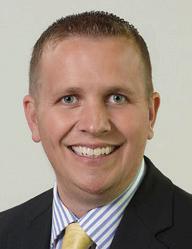

As we approach 2023, the challenge is how MPA maintains this momentum created in 2022. We are currently focusing on more strategies to help grow our membership through referrals, as 88 percent of members said they are likely to recommend MPA membership to a friend or colleague in our membership survey this year. Email campaigns to new licensees will continue to be deployed to both pharmacists and pharmacy technicians. These are just a few ways we will surpass 2022 numbers for new members.
How can you help? Because our members are so engaged, we were able to send out updates on legislative successes such as House Bill 4348, Michigan’s first pharmacy benefit manager (PBM) reform bill, hosting our first hybrid MPA Annual Convention & Exposition and two townhalls, and offering implicit bias continuing education (CE) training as soon as the requirement was passed. Membership renewals are the lifeblood of any association, and if we are going to continue this momentum, we need you to renew.
If you are reading this article and have yet to renew for 2023, please go online or give me a call to renew your membership. Again, thank you for your continued support.

Membership in a professional association benefits the entire pharmacy profession –making it possible to advocate on behalf of our front-line healthcare professionals. Whether you are actively looking for a new career opportunity or you’re an employer looking to engage with qualified pharmacy professionals, the Michigan Pharmacists Association (MPA) has you covered with the MPA Career Center.
As a member who is looking to hire, you receive $100 off every post that you purchase by using the code MPAMEM. Since this is a pharmacy-only job board, your audience is specifically targeted to the people likeliest to apply. Not only will you be posting on this job board, but you can also post to all sites like ZipRecruiter and LinkedIn with the Partner Network at no extra cost.
Whether you are a student who is looking for your first position or an experienced pharmacy professional back on the job hunt, the MPA Career Center has you covered too. Find your next career opportunity by uploading your resume to potential employers who are specifically looking for pharmacy professionals. Take advantage of this valuable member benefit.
The search for the right candidate or a new career opportunity doesn’t stop at the MPA Career Center though. Networking is another valuable benefit of MPA membership. Networking with other pharmacy professionals helps build your reputation and your brand and will allow you to develop relationships that can yield career advice and support. Take advantage of the Career Center and networking opportunities your MPA membership provides by attending MPA events such as the MPA Annual Convention and Exposition (ACE), as well as events at your local county and regional associations.

As part of its mission to ensure pharmacy technicians meet the evolving challenges in medication safety, the Pharmacy Technician Certification Board (PTCB) has launched a new Supply Chain and Inventory Management Certificate. This advanced credential assesses pharmacy technicians’ knowledge of laws and regulations, administrative processes, inventory management, documentation requirements and key players in the supply chain.
Pharmacy technicians play an increasingly vital part in patient care teams, and fluency in supply chain and inventory management can help keep the focus on safety at every step, from the manufacturing

medicine cabinet. By earning this
understanding of supply
responsibilities


BY GREGG S. POTTER, Ph.D., BSPharm., R.Ph., chair, MPA Professional Affairs Committee, professor of pharmacology, Ferris State University College of Pharmacy

A first-year student pharmacist raised her hand during a dermatology lecture I was giving and asked me why none of the images presented during the lecture included patients like her, a person with a dark skin tone. It seemed like an apparent oversight on my part and a request I could easily accommodate. As a result, I planned to include images of patients with darker skin tones in my remaining lectures. However, searching through the required textbook for the course, I could only locate one image of a patient with a dark skin tone.4
I then broadened my search by viewing medical textbooks and journals. Still, in terms of patient and disease characteristics, only a few images were specific enough for me to include in my lectures. Images found on the internet were of inferior quality, unreliable authorship or not always verifiable when depicting disease states. Over the next few lectures, I could only add a few representational images to my content due to the lack of existing resources, as requested by this student pharmacist. — Gregg Potter
happened to me, I might have just labeled the individual provider as racist and assumed that they did not want to give me proper health care because I am a Black woman.
I would not have considered that the educational system for healthcare providers could fail patients with a darker skin tone and their providers in this way. From experience, I know that my skin will never get red, and my symptoms would present on my skin as a darker or purple tone instead of white scratch marks like on a fair-skinned person. One thing I am sure of, healthcare providers need to be able to recognize my symptoms too.
During the lecture, when I first recognized this issue, I felt revolted and sad. It seemed as though the system had failed me, as well as millions of other patients with darker skin tones, who would never get the appropriate medical care because our images were not represented.
— Glodie LubibaDoctor of Pharmacy
candidate class of 2025, Ferris State University, vicepresident, local chapter, Industry Pharmacists Organization
In my first year as a student pharmacist, I began noticing a lack of representation of patients with darker skin tones used during class lectures and in textbooks. During our lectures, we discussed how skin issues and diseases affect patients. Each dermatological disease state was accompanied by images to better understand what to look for in patients. As a person with a darker skin tone, I could not relate to the symptoms as they appeared in class and in the textbook. That made me think if I had any of these skin issues and I went to see a physician or pharmacist for a recommendation, they might either misdiagnose me or be unable to recognize my condition at all. Had this
In the field of dermatology, where images are critical for accurate diagnoses, a lack of images in academic journals and textbooks of patients with darker skin tones has been substantially observed and reported.1,2,3 Healthcare professionals have predominately been taught how to recognize various dermatologic conditions through images of patients with only fair or white skin.1,2,3 Subtle differences in skin tone can influence both diagnosis and therapy. As practicing healthcare professionals, this gap in clinical imagery lessens the ability to provide the same quality of care to patients with darker skin tones.

One measure of skin tone that may be used by dermatologists to aid in diagnostics is the Fitzpatrick Skin Scale. It categorizes skin tone into six types, from fair to dark (Figure 1).5 Darker skin tones include Types

IV (light brown skin) through VI (dark brown or black skin).5 The American Academy of Dermatologists acknowledges a scarcity of images of patients with darker skin tones in the medical literature.2 One study of general medicine textbooks revealed an essential lack of images of people with darker skin tones, with only 4.5 percent of all images of dermatologic conditions in these textbooks depicting patients with dark skin 3
The lack of images of darker skin tones often involves underrepresented minorities and can lead to improper or lack of treatment, resulting in adverse health outcomes. An absence of images for some of the most common dermatologic conditions, such as acne vulgaris, atopic dermatitis and psoriasis, has been reported.6,7 These and many other common dermatologic diseases are underrepresented in medical textbooks in minority populations, considering that in 2021, the U.S. population was made up of 39.9 percent non-white citizens.8
Skin conditions that involve redness or pinkness in light skin tones can be harder to see in darker skin tones. Limited darker skin tone images in medical publications may result in misdiagnosing these conditions and contribute to worse health disparities. For example, Figure 2 shows a comparison of atopic dermatitis (AD) in patients with differing skin tones.9 A difference noted in the pictures is shown between White patients, who usually exhibit flexural involvement when suffering from AD, and Black patients or those with darker skin tones, who more commonly develop extensor presentations.11 Since pathophysiologic differences exist between ethnicities in many dermatologic conditions, it is essential to include images for diagnostic purposes and therapeutic considerations.10

Medical educational training has underrepresented minority populations for years, with an overrepresentation of fair or white skin being the "norm."3 This underrepresentation has been demonstrated in many educational curriculums, including medical, dental and pharmacy schools.12 This raises the question of whether the ethnicity of healthcare educators impacts the lack of representation of darker skin tones in their respective fields of study. Several analyses have prescribed a need for ethnic and racial diversity in medical fields nationwide, specifically in colleges of pharmacy.12,13 Diverse faculty in healthcare education are woefully underrepresented compared to the proportion of minority populations in the U.S. Census.12 For example, Hope et al. reported that in 2021, underrepresented minorities made up only 8.5 percent of pharmacy faculty (medicine 7.1 percent, dentistry 13.9 percent), while the percentage of minorities in the U.S. population was 33 percent.12
One could hypothesize that a more diverse collegiate faculty would be better able to notice an underrepresentation of darker skin tones versus fair skin tones and initiate change. In healthcare, we must better support a diverse environment for learners to enter the profession. Underrepresented minorities only accounted for 18.2 percent of the national enrolling classes for all colleges of pharmacy in 2020.14 Our future healthcare practitioners are noticing healthcare disparities, speaking out and expecting information that relates to all patients they will come into contact with in the future.15 Lecture halls are one place where we educate our future healthcare professionals, and these students are the ones who, in the future, will become the first line of contact with patients of many different ethnicities. If our students are not well prepared today, how are we expecting to see a change in the future?
As healthcare professionals, we must ensure that our therapeutic knowledge base is current and complete. There is an increased need for exposure of healthcare professionals to dermatologic imagery in patients with darker skin tones. Current and future practitioners need extensive imagery of darker skin-toned patients so that these patients are accurately diagnosed and treated for their dermatologic conditions. By 2044, it is expected that darker skin tone patients will make up the majority of the U.S. population.8 Our goal for all health educators is a greater awareness of the clinical presentation of dermatologic conditions of the patients with darker skin tones so that healthcare practitioners can prevent health inequities in minority populations.

For decades there has existed a scarcity of darker skin tone images in medical textbooks, journals and online references.1,2,3 As we increase awareness of the lack of published dermatological images of darker skin tones, we can help prevent adverse health outcomes in underrepresented minorities. Furthermore, expanding the availability of images will aid learners and providers in better recognizing skin conditions in all patients they treat. This enhanced knowledge will improve healthcare outcomes for underrepresented minority patients.
At every opportunity, just like this first-year student pharmacist did, each practitioner must ask for complete and accurate information to best serve all patients. There must be a clear and comprehensive understanding of dermatologic images of patients with darker skin tones. Accepting anything less is an injustice.
References available upon request
the last issue of the Michigan Pharmacist, the Michigan Pharmacists Association (MPA) presented information from the membership priority survey conducted in April 2022 focusing on membership engagement and satisfaction. MPA has since reviewed member insights related to product and service offerings obtained from the survey. The team at MPA is grateful for the time taken by these members to share their experience and insight.


Some of the key findings from members who took the survey include: EDUCATION AND EVENTS
• 69% of members use MPA for continuing education (CE) credits.
• 55% of members prefer in-person CE at MPA Annual Convention and Exposition.
• 54% of members prefer live webinar CE activities.
• 57% of members prefer live in-person CE activities.
• 41% of members selected the Pharmacy-based Immunization Delivery training program as beneficial.
• 40% of members selected the Delivery of Medication Therapy Management (MTM) training program as beneficial.
• 37% of members selected the Multistate Pharmacy Jurisprudence Examination (MPJE) Pharmacy Law Review as beneficial.
• Overall sentiment is that our programs are well received and MPA offers what is of value to members.
• 62% of members said the MPA Michigan Law Simplified book provides great value.
• 54% of members said Controlled Substance Awareness Training provides great value.
• Overall sentiment is MPA offers products and services that are valuable to members.
Which
Which professional training program(s) are beneficial to you?
Pharmacy Tech Prep Online
MPJE Pharmacy Law Review
Delivery of MTM Training
Pharmacy-based Immunization Delivery
Pharmacy Tech Prep Online
Pharmacy Law Review
of MTM Training
Immunization Delivery
Pharmacy Technician Immunization…
Pharmacy Technician Immunization…
Pharmacy Technician Medication…
Technician Medication…
Point of Care Testing Training Program
Point of Care Testing Training Program
Other (please specify)
MPA is using these insights and other information to develop the 2023 plan related to products and services. The insights will shape how MPA plans education, training and professional development offerings. MPA thanks those members who took the time to complete the survey and welcomes member feedback at any time.
(please
10.89% 37.62% 40.10% 41.58% 12.38% 11.39% 30.20% 17.82%
0% 20% 40% 60% 80% 100%
Members could make more than one selection
Members
Members could make more than one selection
Which MPA products/services provide you with the greatest value?
Pharmacy Tech Prep
Pharmacy Tech Prep
Immunization Collaborative Practice Agreement
Immunization Collaborative Practice Agreement
Pharmacy Tech Med History and Reconciliation…
Pharmacy Tech Med History and Reconciliation…
Certified Compounded Sterile Preparation…
Certified Compounded Sterile Preparation…
MPA Michigan Pharmacy Law Simplified
MPA Michigan Pharmacy Law Simplified
MPJE Law Review Human Trafficking
Controlled Substances Awareness Training
MTM Training
Other (please specify)
MPJE Law Review
Human Trafficking
Controlled Substances Awareness Training
MTM Training
Other (please specify)
12.92% 23.92% 9.09% 8.13% 61.72% 23.92% 48.80% 54.55% 31.10% 10.53%
0% 10%
8.13% 61.72% 23.92% 48.80% 54.55% 31.10% 10.53%
0%
Members could make more than one selection
Members could
Members could make more than one selection
selection
If you obtain your CE credits through MPA, which CE formats do you prefer?
Members
Members could make more than one selection
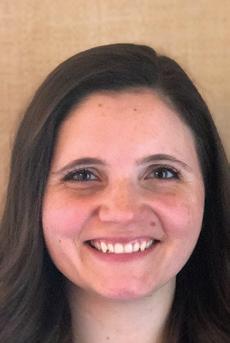

SARAH E. HILL is a community pharmacist at Ascension Michigan Pharmacy in Lansing, where she has been employed for the past 11 years. This pharmacy is embedded in a community mental health facility and serves patients in outpatient, inpatient and adult foster care home settings. Hill’s experiences at this unique practice site have given her insight into different challenges faced by pharmacists in a variety of practice settings. She received her Doctor of Pharmacy degree in 2010 from Wayne State University. Hill has been an active member of the Wayne County Pharmacists Association (WCPA) Board of Directors since she was a student pharmacist, where has held the positions of secretary, president and chair of that local. She has spearheaded several projects for WCPA, including the creation of a television public service announcement on the role of the pharmacist and the organization of an annual Multistate Pharmacy Jurisprudence Examination (MPJE) review for graduating student pharmacists. Hill has served two terms on the Michigan Society of Community Pharmacists (MSCP) Board of Directors and has held the positions of president and chair of MSCP. She was a member of the MPA New Practitioner Committee and has served as a delegate to the MPA House of Delegates. Recently, Hill served a three-year term on the MPA Executive Board representing MSCP. She currently resides in Howell and has been an MPA member for 15 years.
My top priority as president will be to help members with resources for the current staffing crisis. As our profession evolves and pharmacists take on more clinical services, the necessity for highly trained support staff continues to grow. It is exciting for pharmacists to have new clinical opportunities, but they are only possible when our pharmacies are adequately staffed. Pharmacy technicians play a key role in our pharmacies, and we need to create environments that are attractive to individuals contemplating a career as a pharmacy technician. The need for obtaining and retaining a well-trained pharmacy technician workforce has never been higher, and has also rarely felt as insurmountable. We need concrete ideas on how to help our members with this staffing crisis. Recruiting potential technicians from outside of current pharmacy teams and providing comprehensive training to these recruits should be the starting points for rebuilding the technician workforce. Current pharmacy technicians need to have opportunities for growth and advancement to encourage them to continue down their chosen career path. I propose enlisting the MPA Workplace Environment Committee to focus specifically on this issue and provide their suggestions as a resource to our membership. By getting creative and sharing best practices, we can help each other through this challenging time.
Active participation in MPA is vital for all pharmacy professionals in Michigan. MPA gives pharmacy a unified voice when advocating legislatively and when educating the public on the role of the pharmacy team. Many battles we face in advancing the profession could be won if we had the public pulling with us. For this to happen, the public needs to be educated on all that the pharmacy team can provide. The pandemic has shed a whole new light on the importance and accessibility of pharmacy services, and we need to work together to harness this momentum. Being an active member of MPA means contributing to that movement. The best way for MPA to respond to your needs is for you to become actively involved, so that your perspective can be heard. Your time and unique talents will help MPA move forward to a future where all pharmacy professionals feel seen, understood and represented by the association.
The Michigan Pharmacists Association (MPA) is currently holding elections for the 2023 MPA Executive Board. Two candidates are vying for president-elect this year: Sarah E. Hill of Howell and Jesse Hogue of Portage. Read the information provided to learn more about the candidates, and be sure to vote by Monday, Oct. 31.
JESSE HOGUE is the pharmacy education coordinator, PGY1 pharmacy residency director and an emergency department pharmacist at Bronson Methodist Hospital in Kalamazoo, as well as adjunct faculty for the Ferris State University (FSU) College of Pharmacy. He received his Doctor of Pharmacy degree from Ferris in 2001. Hogue is very passionate about serving the pharmacy profession. In addition to serving on the Michigan Pharmacists Association (MPA) Executive Board, Hogue is currently one of the Michigan Society of Health-System Pharmacists (MSHP) representatives to the American Society of Health-System Pharmacists (ASHP) House of Delegates and also serves on the ASHP Commission on Credentialing. Hogue is a past MSHP president and Western Michigan Society of Health-System Pharmacists president. He also served on the MPA Bylaws Review Task Force in both 2016 and 2022. He has served on numerous MSHP and MPA committees and is currently serving as a member of the MSHP Organizational Affairs Committee. Hogue has been an MPA member for more than 20 years and currently resides in Portage.
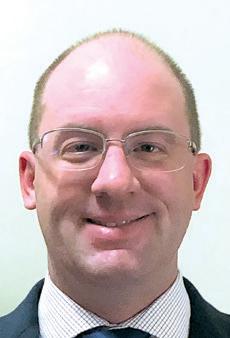

There are SO many issues impacting the practice of pharmacy today, from legislative (pharmacy benefit manager [PBM] reform, 340b, etc.) to practice advancement (expansion of prescriptive authority, advancement of pharmacy technicians, etc.), to workforce challenges (workplace environment, diversity, burnout, etc.). MPA can and should take a leadership role on these issues but will only be successful in those efforts if we have a robust and actively engaged membership. MPA has a dedicated, effective staff, but we have achieved our greatest successes when engaged members have come alongside staff to engage in grassroots efforts. If we were doing a root cause analysis, I would confidently say that engaged members are the root cause of the greatest successes of our association. For that reason, my top priority as president of MPA would be to continue growing and engaging our membership. I believe it is critical to have both – it is great to grow our membership numbers, but if those members are not engaged in working on the many issues I previously identified, we will not be successful. On the other hand, an engaged membership can move the needle on those key issues – and success breeds success. Prospective members are always looking for value – and seeing MPA successfully having a positive impact on issues important to our profession will draw even more members in. This is the positive feedback loop I envision for MPA if we make membership our top priority!
MPA is a membership organization and, as such, is only as strong as its members. As I noted in my answer to the previous question, success breeds success. An actively engaged membership will be far more effective in moving the needle on the key issues impacting our profession, and, as we see success, more pharmacists and technicians will be drawn to join us. One of the strengths of MPA is that we represent all pharmacists and technicians in the state, regardless of practice area. That means that we can come together in a powerful way to make an impact on issues important to all of us, and our diverse perspectives aid us in our advocacy efforts. But that diversity also means that we have a wide range of issues to deal with, which is beyond the capacity of what our great MPA staff can tackle without the help of engaged members. Growing our membership, and making sure those members are actively engaged, is the only way we can successfully address those various issues that are of such importance.

Dr. Hope Broxterman was a kid, she admits that she couldn’t bring herself to look at the scrapes on her knee from falling off a bike – she even cringed at “sock fuzzies” in the bathtub. But now as the incoming President of the Michigan Pharmacists Association (MPA), Broxterman notes that her career path took her unexpectedly into the heart of that childhood angst.

“Little did I know,” Broxterman said, “That when I became a licensed pharmacist, my interest would lie in cardiology, critical care and emergency medicine, where I thrive in code and trauma situations and enjoy being part of a team to ensure our patients are properly cared for.” Broxterman graduated in a class of 18 students from Ellsworth High School in a small northern Michigan village not far from Traverse City. She started considering pharmacy as a profession early in high school.
“I really enjoyed math and science in school and knew I wanted to do something to help people,” she said. “When I was in junior high and high school, I went on a local church’s mission trip to Guatemala. During our time in Guatemala, we built houses, taught, and set up medical clinics where we assessed and treated people for various ailments. It was that experience that made me realize I wanted to go into health care.”
While health care appealed to her, certain aspects were intimidating. She saw nurses doing tasks like starting IVs, placing urinary catheters and cleaning patients – responsibilities that make her appreciate nurses immensely, but brought up that childhood squirm. On the other hand, physicians’ education requirements were daunting – it can take 10 to 14 years to become a fully licensed doctor.
Then a high school aptitude test suggested pharmacy. Broxterman’s mother worked at the small local hospital and was able to set up a job shadow opportunity with the head pharmacist there. She observed pharmacists assisting in sterile compounding and dosing of various medications for inpatients.
“It seemed like a career path where I could make a positive difference for patients,” Broxterman said.
Broxterman attended Northwestern Michigan College in Traverse City to complete her pre-pharmacy courses. It was there she met her husband, Tim, as he was studying at the Great Lakes Maritime Academy. After two years of undergraduate study, Broxterman applied and was proudly accepted into Ferris State University’s College of Pharmacy. That day marked one of her proudest accomplishments.

“I still remember the day I found out I was accepted into pharmacy school,” she said. “I was in my organic chemistry class on break when my dad called to let me know that I had received a letter from Ferris State University in the mail. I was ecstatic to learn that I was accepted into the college of pharmacy, especially after learning that over 800 people had applied for 150 spots.”
After graduating pharmacy school in 2010, her new profession continued to challenge her. Broxterman initially worked as a float
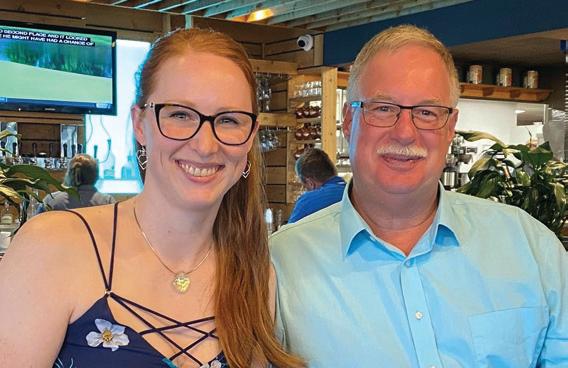
pharmacist with Rite Aid and later accepted a position at Munson Medical Center as a midnight pharmacist. After three years paying her dues on the graveyard shift, a daytime position opened up, and Broxterman was able to transition into a position focused on what would become her true calling – cardiology.
While serving patients in this setting is hugely gratifying, Broxterman has also found connection and fulfillment through her involvement with MPA.

Her first year of pharmacy school, her professor Dr. David Miller offered extra credit to student pharmacists who became MPA members and attended the Annual Convention & Exposition (ACE). At the time, she knew nothing about MPA or what professional organizations did, but the experience made an impression.
“I remember being honored to be in the presence of such great leaders,” Broxterman recalled.
Since then – besides one year when the conference occurred during her first week at a job – she hasn’t missed a single ACE. As a P4 student, preceptors Drs. Michael Tiberg and Terry Bauman – members of the Michigan Society of Health-System Pharmacists (MSHP) – invited her to attend MSHP’s Committee Day. That was when she knew she wanted to continue her involvement after graduation. It was clear MSHP and MPA offered many options for her to help advance the profession and continue learning.
MPA and MSHP’s success in reaching their goals, of course, depends on the time and dedication of its members, Broxterman notes – whether by helping educate pharmacy professionals through continuing education, serving on committees that address workplace burnout, being a regional

“There is an opportunity for every member to be involved,” Broxterman said.
As Broxterman prepares to embark on her term as president in 2023, she believes MPA has a great opportunity to build on the strong groundwork it has already laid. Just as her own career path led to places that felt uncomfortable at first, Broxterman believes advancing pharmacy means embracing new challenges.


“While COVID-19 changed many things over the last couple of years, some of those changes, particularly for pharmacy, have been positive,” Broxterman noted, citing expansions in vaccine administration and the ability to prescribe the COVID-19 antiviral medication Paxlovid.
“Pharmacists are front-line care providers in our communities, and this is our moment to advance our profession’s capabilities based on what we’ve already demonstrated.”
Broxterman will continue MPA’s work with state legislators to allow pharmacists to consult, prescribe and dispense birth control without delegation from a physician – yet another opportunity to expand care and positively impact communities.

“My presidential focus is to build on recent momentum,” Broxterman said.
Part of driving that momentum forward is telling pharmacists’ stories, she said – stories of how pharmacists deliver care to those most in need, make a difference in patient care, and have been reliable and dedicated members of the healthcare team. It’s time to “incorporate these achievements into our legislative message,” she said.
“Ambitiously, I hope to lead our organization, with many hands involved, to create a buildable framework that helps address challenges pharmacists face in their professional efforts to deliver care,” Broxterman said. “This is our moment.”
“Ambitiously, I hope to lead our organization, with many hands involved, to create a buildable framework that helps address challenges pharmacists face in their professional efforts to deliver care.”


It is a pleasure to serve as president of the Michigan Society of Pharmacy Technicians (MSPT) this year. I’m honored to be joined by a passionate team of pharmacy technicians serving on the MSPT Board of Directors. This issue of the Michigan Pharmacist is focused on the state of the pharmacy technician profession.
BY ADAM KING, MPH, CPhT, PRS, president, MSPTWhen I came to the profession 14 years ago, pharmacy technicians were relegated to three types of pharmacy practice: retail, hospital and long-term care. Pharmacy technicians at the time were either on a path to starting pharmacy school or using the profession to pay for other types of university degrees. Much of this landscape has changed.
Pharmacy technicians have more places to practice. My good friend Liza Chapman has an article next to this one on the state of our profession. In the rest of this article, I’m going to feature a few of my friends who practice in more unusual roles.
Cody is a pharmacy technician that works in pharmacy information technology for Trinity Health in Grand Rapids. His main role there is maintaining the pharmacy module for the Electronic Medical Record (EMR) system. Cody received most of his pharmacy training through
Dori is another passionate pharmacy technician that has built a career with her choice of profession. She previously worked in community pharmacies for a healthcare system. Like Jacob, she is supervised by doctors and not pharmacists. In her current primary care role, she verifies the accuracy of patients’ prescriptions, processes prior authorizations and processes medication refill requests for her office.
Leadership is another area that pharmacy technicians can advance their careers. Project management and workflow improvement are part of the continuous process improvement model for many pharmacies. My friend Erith does this for a company that makes mobile applications and IV automation for pharmacies. Her previous roles in pharmacy supervision and training new pharmacy technicians in the hospital system have prepared her for this role.
Keith trains new pharmacy technicians and serves as the program director of a community college in the Detroit area. Keith has a long career in community and health-system pharmacy. His previous roles, along with a Bachelor’s Degree and now a Master’s Degree, prepared him for this role.
“Leadership is another area that pharmacy technicians can advance their careers. Project management and workflow improvement are part of the continuous process improvement model for many pharmacies.”
Walgreens and Lakeland Health. To add on to his pharmacy knowledge, he holds a Bachelor’s Degree in biomedical sciences.

Next, consider my friend Jacob’s career. He previously worked as an oncology pharmacy technician for a clinic in Macomb Township, Mich. In that role, he worked under the supervision of a doctor, not a pharmacist. In Michigan, we are not constrained by our type of supervisor. Today, Jacob works for a specialty pharmacy and assists patients in navigating insurance and copay card programs.
The point of my letter to you, my colleagues, is to encourage you not to be constrained by the standard three areas of practice. Take some time to find your strength in our field, ask the advice of your pharmacists and follow your profession. Fourteen years ago, I found my passion.
My hope is that you find yours in the coming years. Thank you for your service to the citizens of Michigan. I hope that, like me, you have found a career as a pharmacy technician.




Twenty years ago, many people might have viewed pharmacy technicians as primarily administrative positions with regular turnover. In 2022, that couldn’t be further from the reality of the state of the profession. The pharmacy technician role has evolved into a fulfilling long-term career with a wide range of opportunities for advancement. Technicians have gone from support staff to leaders, from having limited responsibilities to providing direct patient care services, and from background employees to frontline heroes.
BY LIZA CHAPMAN, Pharm.D., FAPhA, vice president, partnership development, Pharmacy Technician Certification Board
But as with any other occupation, turning a job into a thriving career takes commitment - a quality that has become a defining characteristic of pharmacy technicians. As a pharmacist, I can personally attest to the difference a skilled, dedicated technician can make to pharmacy operations, workflow and – most importantly – patient safety.

Recent data from the Pharmacy Technician Certification Board's (PTCB) 2022 Workforce Survey revealed that pharmacy technicians have high levels of career satisfaction – 84 percent of national respondents and 90 percent of Michigan respondents reported being somewhat to very satisfied with their job. This is an important metric to consider, especially after the Michigan Pharmacists Association’s (MPA) Pharmacy Workplace Environment Task Force concluded in 2021 that a pharmacist’s stress levels can depend on how engaged their team is. In contrast, high levels of dissatisfaction can exacerbate the staffing shortages we currently face nationwide. And as we know, higher stress contributes to inefficiencies, which results in a stagnant workflow.
But career satisfaction isn’t the only indicator of potential professional growth. A significant number
of technicians – particularly those who earn specialty and advanced credentials – say they are committed to the field for the long haul. That same PTCB survey found that more than half of respondents in Michigan and nearly 60 percent of national respondents consider pharmacy technician their long-term career. And per the MPA Task Force’s recommendations for workplace improvements, more technicians are pursuing certifications – 70 percent of respondents in the state (compared to 80 percent nationally) are currently certified by PTCB, with 57 percent certified for six years or more (on par with national data).
MPA Executive Board Member Angela Faszczewski, CPhT-Adv, is an excellent example of a technician who is not just dedicated to her own career but to advancing the profession as a whole. A certified technician since 1997, she has since earned five advanced certifications and became an Advanced Certified Pharmacy Technician (CPhT-Adv) last year. Angela remains committed to her career because of her passion for advocating for her patients and for opportunities to take on new leadership challenges that help steward the field’s evolution, like serving as both the president of PTCB’s Certification Council and the chair of our Exam Development Committee.
Because health care is a rapidly growing – and changing – industry, it requires a workforce that doesn’t just keep pace but gets ahead of the curve. Pharmacy technicians have become invaluable partners for pharmacists and as their responsibilities continue to expand, so does the need for accessible advanced specialized training and credentialing. In the face of a pandemic, technicians stepped up to administer immunizations and facilitate diagnostic testing to ensure patients were treated
quickly and efficiently. Recognizing the immediate demand for these skills, many technicians earned PTCB’s Immunization Administration and Point of Care Testing Certificates to ensure they provided the best care possible, even during the crisis. An effective pharmacist-pharmacy technician relationship is based on knowledge, communication and trust, and specialized certifications empower technicians to become effective, collaborative partners.
But if there was ever a doubt about the growing importance and value of a technician’s perspective, consider this: 13 states, including Michigan, have included a technician on their Boards of Pharmacy. Regulators can’t effectively oversee an industry by excluding a significant portion of its workforce. Giving technicians a seat at the table gives them a say in the policies and regulations that govern their profession and shapes guidelines that best support pharmacy operations and advance patient safety.
Recently appointed to the Michigan Board of Pharmacy by Governor Gretchen Whitmer, Keith Binion, MEd, CPhT, embodies the type of leadership today’s technicians bring to that table. As a practicing technician, executive director of the Pharmacy Technician Educators Council (PTEC), and member of the MPA Hall of Honor, Keith has already played an important part in elevating the profession by training new generations of pharmacy technicians. But as a regulator, he can help ensure any new regulations will support and facilitate opportunities to educate and advance the profession in the state and address challenges unique to technicians.
While the pharmacy technician field has made huge strides, we must ensure it continues growing. This means working to understand – and address – the unique stressors technicians experience that can negatively impact them. The pandemic has made it even more challenging for pharmacies to retain existing technicians and attract new ones, leaving the field in a constant state of stagnation. PTCB’s survey found that a majority (90 percent) of respondents from Michigan said they have taken on somewhat too much more work to meet the growing demands of their jobs due to COVID-19.
While COVID-19 stressors were a leading factor for technicians who decided to leave the profession in Michigan and nationally, the majority of these technicians cited low pay and lack of opportunities for career advancement as significant reasons for leaving the field. Pandemic or not, we need to continue to identify ways to support and empower such an ambitious and dedicated workforce who are central to patient and medication safety to grow the careers they love. An investment in pharmacy technicians is an investment in the future of pharmacy. And one that will pay dividends for patients, employers and the profession for years to come.
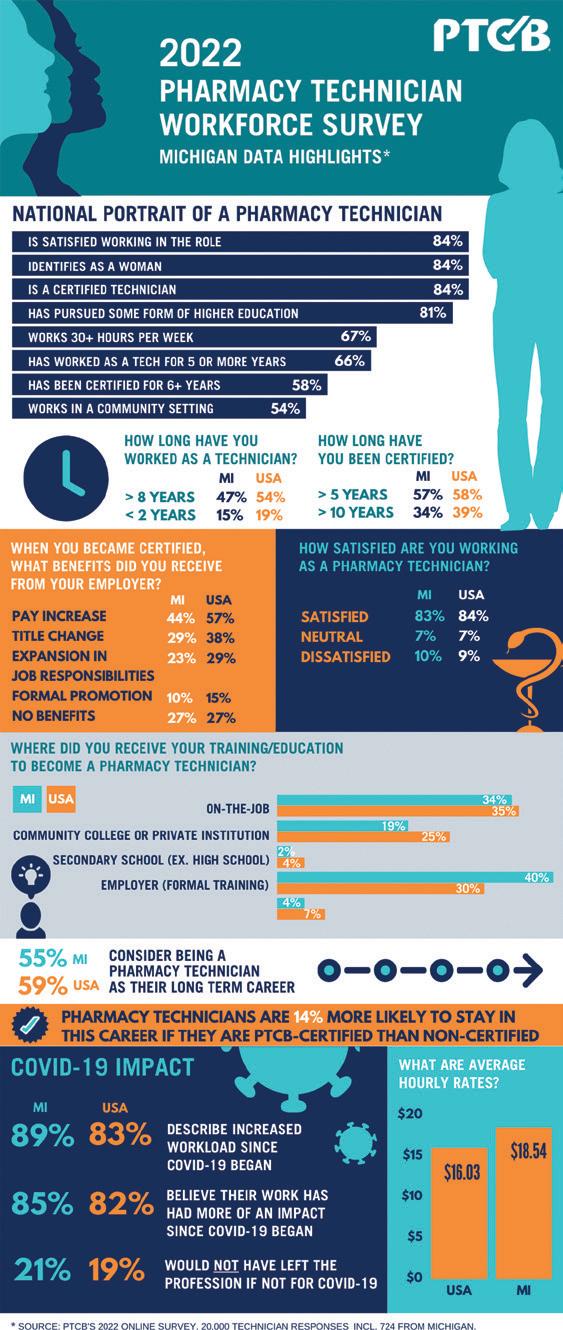
Dr. Chapman serves as PTCB’s vice president of partnership development, where she is responsible for developing partnerships with the pharmacy community, including educators, employers, state and national pharmacy associations, and state boards of pharmacy to advance pharmacy technician roles and responsibilities and medication safety.
Previously, Dr. Chapman was pharmacy clinical sales manager for the Kroger Co. Atlanta division, where she coordinated and managed all patient care services. She has held various volunteer leadership positions, including past president of the Georgia Pharmacy Association (GPhA). Currently, she serves as chairperson of the Georgia Pharmacy Foundation Board of Directors, a member of the Pharmacy Compounding
Foundation Board of Directors, and is a member of several national professional organizations, the American Pharmacists Association (APhA), American Society of Health-System Pharmacists (ASHP) and the National Community Pharmacists Association (NCPA). Dr. Chapman is also a proud member of the Michigan Pharmacists Association (MPA).
Disclaimer: This article is not designed to address political, religious or moral issues related to reproductive health care. It is meant to convey legal guidance and information, as of the time of publication. The Michigan Pharmacists Association (MPA) will continue to update membership on developments at the federal and state level. In addition, MPA has formed a Reproductive Health Work Group, chaired by Julie Janeway, MSA, JD, and consisting of pharmacists, pharmacy lawyers and legislative relations specialists, to follow the changing landscape and provide members with the most up-to-date advice and information going forward.
At this time, abortion is legal in the state of Michigan.
BY JULIE JANEWAY, MSA, JD, senior healthcare counsel, Foley, Baron, Metzger & Juip, PLLC; chair, MPA Reproductive Health Work GroupA 1931 law banning abortions except to save the mother’s life has been struck down. The law came into play on June 24 when the U.S. Supreme Court overturned Roe v. Wade (1973) and Planned Parenthood v. Casey (1992) in the case of Dobbs v. Jackson Women’s Health Organization. Dobbs holds that the U.S. Constitution does not confer a right to abortion and that individual states have the authority to regulate it.
In May, an appeals court judge suspended the 1931 ban following an infamous leak of the Supreme Court opinion, and, on Sept. 7, the same judge formally struck down the ban on the grounds that it violates the Michigan Constitution. The Legislature could choose to challenge that decision in the Michigan Supreme Court. Separately, Gov. Gretchen Whitmer filed a lawsuit April 7 to ask the high court to rule on whether the state constitution protects the right to abortion. While the Supreme Court has not acted on either question, voters will decide in November whether to amend the state constitution to explicitly protect the right to abortion. For Michigan licensed pharmacists, no changes in pharmacy practice are necessary at this time, but some frequently asked questions follow.

Does the Dobbs v. Jackson decision or the 1931 Michigan law affect the sale of contraceptives, including Plan B, in Michigan?
The U.S. Supreme Court’s decision does not impact the use or sale of contraceptives. Penalties in the 1931 ban would apply strictly to abortifacients, not contraceptives. Emergency contraceptives like levonorgestrel, or Plan B, are not abortifacients; they are contraceptives and would have remained legal even under the 1931 law.

Will state government departments cooperate with authorities from other states where abortion is restricted/illegal in investigating any provider who assists in reproductive healthcare (abortion) for a citizen of the other state?
Gov. Whitmer’s Executive Directive No. 2022-5, signed May 25, instructs all state departments and agencies not to cooperate with authorities from other states in any investigation or proceeding against anyone for obtaining, providing or assisting someone else in obtaining or providing legal reproductive health care in Michigan.
Could the Michigan Department of Licensing and Regulatory Affairs (LARA) take any licensing action for violation of the 1931 law?
Unless it is challenged successfully in the Michigan Supreme Court, the 1931 law is considered unconstitutional and has been struck down. However, if it came into play, under the Executive Directive described above, LARA’s Board of Pharmacy (and other healthcare licensing boards) would not take action against any licensed healthcare professional for providing legal abortion services, including dispensing medication that can be used for medical abortions.
I am licensed in Michigan as well as a state with a trigger law or other existing abortion ban. What should I do?
• Contact that state’s board of pharmacy for guidance.
• Monitor local and state news regarding the enforcement of any state laws that the overturning of Roe may have triggered.
• Be familiar with that state’s abortion law, and, if there is one:
- Be prepared to have necessary conversations with patients and prescribers in a nonjudgmental way, especially if attempting to determine the intended purpose of a prescription.

- Employ due diligence in determining the intended use for short-term, high-dose misoprostol or any other medication that can have a potential adverse effect on a fetus.
o Check for diagnosis codes on misoprostol electronic prescriptions.
Did a federal judge rule that Emergency Medical Treatment and Active Labor Act (EMTALA) provisions regarding the performance of abortion do not apply? Is that true in Michigan?
A federal judge on Aug. 23 ruled that, under Texas law, EMTALA provisions and related U.S. Department of Health and Human Services guidance do not apply in Texas. This case is relevant to Texas only. EMTALA requires that for any individual presenting to a hospital with an emergency medical condition, the hospital is required to provide the emergency care necessary to save that individual’s life, including abortion care. Note, under federal law, Medicaid covers abortion services only in cases of rape, incest or if the patient’s life is in danger.
"Always document the “who, what, when, where and why” of the conversation with the prescriber and sign/initial it. MPA also encourages pharmacies, if they are refusing to provide care, to offer patients an alternative, facilitated means to receive the requested care."
A statutory or regulatory conscience clause, which is recognized via a patchwork of federal laws with variation among state statutes, allows pharmacists and other healthcare providers the right to refuse to provide certain services based on a violation of personal beliefs or values.
According to the Guttmacher Institute, 46 states, including Michigan, explicitly allow some healthcare providers to refuse to provide abortion services. Twelve states, not including Michigan, allow some healthcare providers to refuse to provide services related to contraception.
In several states, pharmacy boards have issued guidance that permits a pharmacist to refuse to dispense medication as long as the patient’s access to the medication is protected by “facilitated referrals” for the filling of the prescription, according to the journal U.S. Pharmacist. Other states have enacted legislation or issued guidance that requires pharmacies to fill any lawful prescription for birth control.
Michigan lawmakers have at least twice attempted to pass legislation to protect conscientiously objecting healthcare workers from “civil liability, criminal action, administrative or licensure action” and “termination of employment or refusal of staff privileges at a health facility,” but were unsuccessful.
Final guidance: Document, document, document. Check the prescriber’s intent if the drug is an abortifacient or can cause birth defects. If the pharmacist fills the prescription, they should include a diagnosis, diagnosis code or a state-approved exception, if applicable. If the pharmacist opts to refuse to fill the prescription on the grounds of moral or religious objections, notes should be placed in the pharmacy’s electronic prescription system as to the reason. Always document the “who, what, when, where and why” of the conversation with the prescriber and sign/ initial it. MPA also encourages pharmacies, if they are refusing to provide care, to offer patients an alternative, facilitated means to receive the requested care.

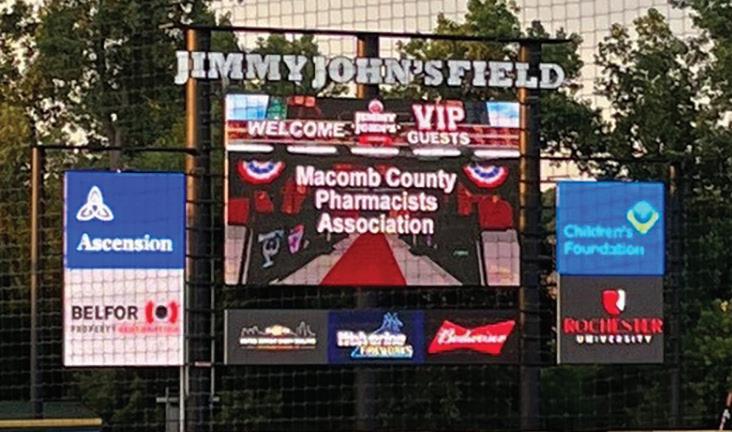 BY JOHN BRUBAKER, chair, Macomb County Pharmacists Association
BY JOHN BRUBAKER, chair, Macomb County Pharmacists Association
Number of years as MPA Member and number of years with local?
I’ve been an MPA member for over 20 years and a member of the local since then but became more active in the past three years.
When was your local formed? MCPA was formed around 1979.
How did you learn about your local association?
I knew about MCPA when joining MPA as it was mentioned that I should pick a local to join. I chose Macomb County as that is where I reside and where, at the time, I was practicing pharmacy.
Where and when does your local hold meetings?
Our local has been meeting via Zoom, and we have used the same room since the pandemic started. Our meetings are held on the third Thursday of the month. However, we do not hold meetings in February, July, August and December. Our meeting time is 7 p.m. When we do get back to meeting in person, we will meet at the Clinton-Macomb Main Branch Library on Romeo Plank Road. You may contact me for the Zoom link; we also send out meeting reminders via Mail Chimp and our Facebook page.
Why do you feel it is valuable to support and join a local association? How has it benefitted you?
I feel that the local is the grassroots of the MPA organization. It is the place where you can meet others who practice in your community, exchange ideas with those in different pharmacy practices and share those ideas on how to improve the pharmacy practice and help our patients with their health needs. It is also a very good place to learn how to run a meeting, learn Robert’s Rules of Order and how to run an organization. This can lead to bigger opportunities such as MPA Executive Board or MPF Board of Trustee positions. I’ve become more open and ready to meet more pharmacists and technicians to help them get involved in the community.
Do you have a favorite event or memory related to your local?
There are many memories, but what stands out is helping our student pharmacists grow and become leaders of tomorrow.
Please list any upcoming events: MCPA is planning on some form of scavenger hunt or member gathering in the fall or winter.
From left, Macomb County Pharmacists Association Board member Dena Welicki, MCPA President-Elect Jennifer Priziola and MCPA President Denise Markstrom attend the Macomb County Families Against Narcotics “Run Drugs Out of Town” event in June.

Who is a good contact at your Local for further information and questions?
The best contact is, John Brubaker, (586) 255-4422 or email jackandjohn@comcast.net
Oct. 18: Wits & Wagers CE Program at 6 p.m. Sparrow Professional Building
Oct. 29: CAPA serving at Advent House
Dec. 8: Law Update CE, Time TBD
Dec. 31: CAPA serving at Advent House
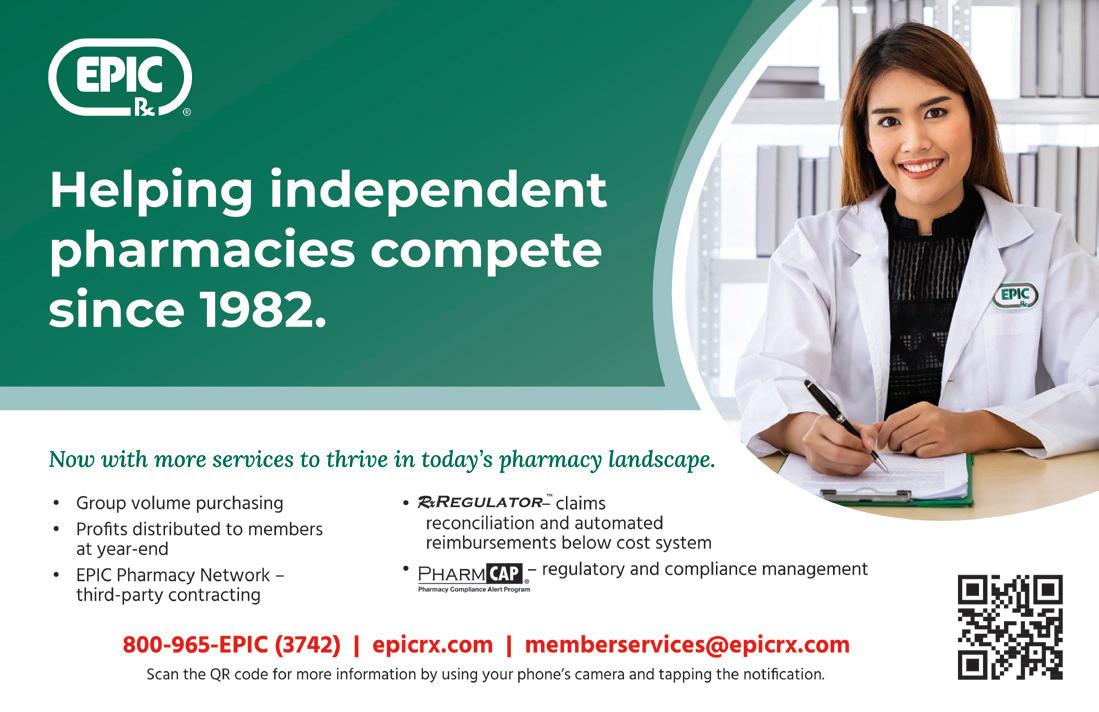
Oct. 20: Monthly Meeting, 7 p.m., Zoom/Hybrid
Nov. 17: Monthly Meeting, 7 p.m. Zoom/Hybrid
Oct. 18: Monthly Meeting, 7:30 p.m., TBD for Zoom or hybrid
Nov. 15: Monthly Meeting, 7:30 p.m., TBD for Zoom or hybrid
Kent County Pharmacists Association (KCPA)
Oct. 18: Monthly Meeting, TBD
Nov. 15: Monthly Meeting, 7:30 p.m.
Jan. 17: Monthly Meeting, 7:30 p.m.
Feb. 21: Monthly Meeting, 7:30 p.m.
Oct. 13: Monthly Meeting, 7 p.m.
Nov. 10: Monthly Meeting, 7 p.m.
Dec. 8: Monthly Meeting, 7 p.m.
If would like to join meetings, please email hanadithomas@yahoo.com
Oct. 19: Monthly Meeting, 7 p.m., 501 Grill in Flint
Elections: Members emailed in late October to cast their vote. As always, we are seeking nominees. Anyone interested can reach out to Thomas Breeden at Thomas.breeden@ascension.org
End of year/Holiday party: Late December, likely at Brick Street in Grand Blanc, details pending.
Nov. 9: Monthly Meeting, 7:30 p.m.
Dec. 14: Monthly Meeting, 7:30 p.m.
Target Audience:
This activity was developed for pharmacists, pharmacy technicians and student pharmacists.
Disclosure Statement:
This author has indicated they do not have any conflicts of interest nor does she have financial relationships with a commercial interest related to this activity.
Learning Objectives:
At the end of this activity, participants should be able to:
1. Describe the impact of tobacco use among different patient populations in Michigan.
2. Review the medications currently approved to deliver nicotine replacement therapy (NRT).
3. Identify opportunities to increase patient access to pharmacist treatment.
Commercial tobacco use is the largest contributor to preventable death, disease and disability in Michigan.1
In 2019, more than 17,000 deaths (18 percent of all deaths in Michigan) were linked directly to tobacco use. Disproportionately impacted populations, including people with low socioeconomic status (SES), racial minorities and LGBTQ+ (lesbian, gay, bisexual, transgender, queer, etc.) individuals are more likely to smoke and suffer from related health conditions.2

While rates of tobacco use have been declining, many people still find it challenging to quit. According to the Centers for Disease Control and Prevention (CDC), nearly 70 percent of smokers want to quit, but less than one in 10 quits successfully each year.3 The costs of smoking in Michigan are also staggering—$4.59 billion in healthcare costs and $4.78 billion in productivity losses each year. Per household, the cost of smoking-related death and disease is $981.4
To address chronic illnesses, including those caused by smoking, states have been broadening the scope of practice for pharmacists. Allowing pharmacists to prescribe independently has been shown to improve some clinical outcomes.5 Pharmacists are well-qualified to prescribe all U.S. Food and Drug Administration (FDA)approved tobacco cessation medications, including nicotine replacement therapy (NRT) products. Through doctoral-level studies, pharmacists have extensive training on medications and interactions, allowing them to navigate complex patient needs. Many also receive
training directly on tobacco cessation, and courses are available to continue education on the topic.6
Currently, there are five medications approved by the FDA to deliver NRT: over-the-counter products such as patches, gum and lozenges; and prescription-only nasal sprays and inhalers.7 Two other medications, Chantix (varenicline) and Zyban (bupropion), are oral medications that work to block the rewarding effects of nicotine in the brain. Previously, varenicline and bupropion were labeled with a special boxed warning, the highest warning the FDA can give that a medication may have serious health effects, but the FDA removed this warning in 2016. Since 2004, New Mexico has permitted pharmacists to prescribe all seven tobacco cessation treatments listed above safely with no adverse effects being reported.6,8 In New Mexico, 18-25 percent of patients who consulted with a pharmacist about cessation options had quit smoking within six months of starting NRT.9 It is important to cover all these medications because some combinations of NRT products produce significantly higher quit rates when used together.8,10 Relative odds of success for various medications and treatments are provided in Figure 1. Cessation success varies from 1.7 times more likely with nicotine gum to 2.9 times more likely with varenicline (as compared to a placebo treatment).
In Michigan, pharmacists may not prescribe any medications without delegation from a physician, working under a collaborative practice agreement (CPA), or a statewide standing order.11 Many other states have these mechanisms in place, but Michigan is unclear in this area and does not have a standing order for cessation medications.10,12 Instead, individual CPAs are currently the only option.13–15
Beyond Michigan, 17 other states have taken action to allow pharmacists to prescribe tobacco cessation products. For a complete list of what other states have passed, see Sachdev et al. 2020, “Current status of prescriptive authority by pharmacists in the United States.”10

States vary in what they cover of the seven FDA-approved cessation medications, and the method of permitting prescribing also varies (see Figure 3).8 Delegating prescriptive authority to pharmacists at the state level is necessary to see the full benefit of increased access, convenience and cost-effectiveness. The Michigan Pharmacists Association, Centers for Medicare & Medicaid Services (CMS),16 Tobacco Control Network12(p) and the National Alliance of State Pharmacy Associations all support allowing pharmacists
to fully utilize their training and build upon existing relationships with patients by prescribing tobacco cessation products.17
For further information, visit www.Michigan. gov/tobacco, or contact Karalyn Kiessling, manager of the Smoke-Free Environments Law Project in the Tobacco Section of the Division of Chronic Disease and Injury Control, Michigan Department of Health and Human Services, by email at kiessli@umich.edu or phone at (517) 335-8376.
To earn continuing education credit, free through Jan. 31, 2023, please visit www. MichiganPharmacists. org/Education/online or scan the QR code.
Upon the completion of this activity, participants must complete an online evaluation. Participants will receive pharmacy continuing education (PCE) credit through CPE Monitor, a national collaborative effort by ACPE and the National Association of Board of Pharmacy (NABP) to provide an electronic system for pharmacists and pharmacy technicians to track their completed PCE credits. MPA, as an ACPE-accredited provider, is required to report pharmacist and pharmacy technician PCE credit using this tracking system. Pharmacist and pharmacy technician participants must provide their NABP e-Profile identification number and date of birth (in MMDD format) when they complete a PCE activity. It will be the responsibility of the participant to provide the correct information. If this information is not correctly provided, NABP and ACPE prohibit MPA from issuing PCE credit. Online access to their inventory of completed credits will allow pharmacists and pharmacy technicians to easily monitor their compliance with PCE requirements and print statement credit. Partial credit will not be awarded. If you have not yet signed up for CPE Monitor, go to http://nabp.pharmacy/programs/ cpe-monitor/. For more home study activity options for pharmacists and pharmacy technicians, visit http://www.michiganpharmacists.org/ education/online
Michigan Pharmacists Association is accredited by the Accreditation
for Pharmacy Education
ACPE Universal
a

of
pharmacy
It’s hard to believe that we are three-quarters of the way through 2022. Looking back, it makes one wonder, where did this year go? It’s been challenging for many, and not all for the same reasons. Life happens, and we try to take it in stride.
BY RON DEVERS, CIC, CPIA, director of operations, PSI Insurance Agency
Each year in the insurance industry, many months are dedicated to various “awareness” campaigns. May is Disability Insurance Awareness Month, April is Distracted Driving Awareness Month, September is Life Insurance Awareness Month, and October is Cyber Insurance Awareness Month.
While many industries pay special attention to various facets of the professions, I feel strongly that we must promote a variety of insurance products, not just at special times. Cyber liability insurance is getting a lot of attention presently, as we hear in the media that more and more companies are being subjected to different cyber-attacks from a variety of sources. The dark web provides an open marketplace for private information that hackers can gather for their attacks on unsuspecting owners. Think of all the information that you store on your servers. Personal Identifiable Information (PII) consists of information that identifies each of us individually, such as dates of birth, social security numbers, drivers’ licenses numbers, banking info, home addresses and so on. With this information, cyber-criminals can wreak havoc on someone’s life. Protected health information is similar, but it relates to the information that identifies an individual and their personal health care data.
Ransomware is also on the rise. This is when a cyber-
criminal installs malware into your system, usually via an email that someone might open called a “phishing” email, which shuts down your system. Then, you’re contacted to pay a ransom in order to get the key that will restore your system and release the information back to you. Insurance companies are offering endorsements to homeowners’ policies to provide some personal protection against cyber-attacks, and business policies are endorsing coverage as well. An alternative is to purchase a separate cyber insurance policy. There are options. Experts estimate that for healthcare breaches, the cost to restore the information is between $250 and $320 per record.
One final thought about life insurance. On Feb. 18, 2022, I talked with my older brother, Vic, and he excitedly told me he had turned in his retirement papers, bought a boat and was moving back to Michigan from Wisconsin to be closer to his kids and grandchildren. On Feb. 22, I got a call that my brother had passed away from a sudden massive heart attack. My nieces were distressed about how things would be done and paid for, and I assured them that my brother had planned in advance. He had life insurance that would settle his debts, take care of final expenses and leave some money for his children. While I miss my brother, I’m so happy we had the difficult discussion about his desire to provide for his family. Feel free to contact PSI Insurance Agency with any of your insurance needs.






COVID-19 has forced a significant increase in the number of vaccinations pharmacies administer daily. With this increase also comes additional audits. PAAS National® frequently sees pharmacy benefit managers (PBMs) audit for all vaccinations, including influenza. Now is the time to check that you have all documentation in place for this year’s flu shot season.
What you will need for an audit:
• A signed order from an authorized prescriber or
• A signed protocol that is up to date and includes specific vaccination(s) to be administered.
• Check dates and vaccines on your protocols to ensure they are up to date.
• Have current VIS forms printed for each vaccine you administer.
BY TRENTON THIEDE,Pharm.D., MBA, president, PAAS National®, expert third party audit assistance and FWA/HIPAA compliance
o When using a protocol, create a placeholder prescription with all prescription elements.
2. Vaccination Information Statement (VIS)
• Required to be given to patient prior to each administration.
• Be sure you have the most current VIS forms.
3. Vaccination Administration Record (VAR)
• Name of vaccine administered
• Lot and Expiration Date of vaccine given
• Site of administration (i.e. right arm)
• Signature or initials and title of person administering
• What VIS form was given
• Form can be used as proof of receipt on audit VAR and VIS forms, and information regarding what the Centers for Disease Control & Prevention (CDC) requires for healthcare providers to record, can be found on the CDC website 1
• Have VAR forms printed and educate all staff on how to complete the forms.
• All vaccines should be submitted using days’ supply of “1.”
• All vaccines administered with protocol should be submitted with origin code of “5” (pharmacy created).
• Be sure the correct quantity is billed, typically 0.5 mL, but you may need to consult with the software vendor for guidance.
• Keep vaccine documents stored in a system that makes access easy in case of an audit.
PAAS National® is committed to serving community pharmacies and helping keep hard-earned money where it belongs. Contact us today at (608) 873-1342 or info@ paasnational.com to see why membership might be right for you.
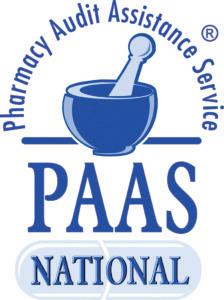
Copyright © 2022 PAAS National, LLC. Unauthorized use or distribution prohibited. All use subject to terms at https://paasnational.com/terms-of-use/
References:
1. https://www.cdc.gov/vaccines/hcp/admin/document-vaccines.html
